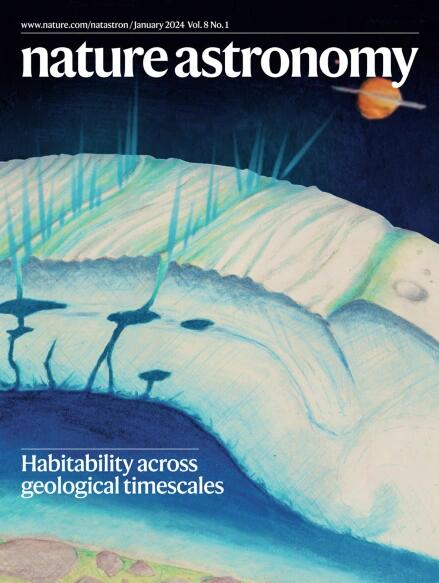低质量系外行星流体动力逃逸机制的特征
IF 14.3
1区 物理与天体物理
Q1 ASTRONOMY & ASTROPHYSICS
引用次数: 0
摘要
大气流体动力逸出是低质量近地行星群体的特征。然而,由于涉及许多物理因素,区分富氢大气流体动力逸出的驱动机制是一项复杂的任务。通过模拟,我表明流体动力逸出可以完全由沉积在大气下层的热能驱动,但前提是行星的杰恩斯参数低于3。否则,就需要额外的外源驱动因素。为了确定这些驱动力的特征,我们引入了一个考虑到潮汐力的升级版杰恩斯参数。当升级后的杰恩斯参数低于 3 或超过 6 时,大气逃逸分别主要由潮汐力或来自主恒星的极端紫外线辐射驱动。在 3 到 6 的范围内,这两个因素都能引发大气逸散。升级后的杰恩斯参数与基础物理学密切相关,它提供了一种简明的方法来对流体力学逸出的驱动机制进行分类。这些结果也可用于行星演化计算。本文章由计算机程序翻译,如有差异,请以英文原文为准。


Characterization of the regimes of hydrodynamic escape from low-mass exoplanets
Atmospheric hydrodynamic escape sculpts the population of low-mass close-in planets. However, distinguishing between the driving mechanisms responsible for the hydrodynamic escape of hydrogen-rich atmospheres is a complex task due to the involvement of many physical factors. Using simulations, I show that hydrodynamic escape can be driven solely by thermal energy deposited in the lower layers of the atmosphere, but only if the planet’s Jeans parameter is below 3. Otherwise, additional exogenous drivers are necessary. To characterize these drivers, an upgraded Jeans parameter that takes into account tidal forces is introduced. When the upgraded Jeans parameter falls below 3 or exceeds 6, atmospheric escape is primarily driven by tidal forces or extreme ultraviolet radiation from the host star, respectively. In the range 3 to 6, both factors can trigger the escape of the atmosphere. The upgraded Jeans parameter, which is closely related to the underlying physics, provides a concise method for categorizing the driving mechanisms of hydrodynamic escape. The results can also be applied to planetary evolution calculations. An updated Jeans parameter that includes tidal forces can distinguish the various driving forces, both exogenous and endogenous, of atmospheric escape from low-mass close-in exoplanets. Depending on its value, escape can be dominated by tidal forces, extreme ultraviolet stellar radiation or a combination of the two.
求助全文
通过发布文献求助,成功后即可免费获取论文全文。
去求助
来源期刊

Nature Astronomy
Physics and Astronomy-Astronomy and Astrophysics
CiteScore
19.50
自引率
2.80%
发文量
252
期刊介绍:
Nature Astronomy, the oldest science, has played a significant role in the history of Nature. Throughout the years, pioneering discoveries such as the first quasar, exoplanet, and understanding of spiral nebulae have been reported in the journal. With the introduction of Nature Astronomy, the field now receives expanded coverage, welcoming research in astronomy, astrophysics, and planetary science. The primary objective is to encourage closer collaboration among researchers in these related areas.
Similar to other journals under the Nature brand, Nature Astronomy boasts a devoted team of professional editors, ensuring fairness and rigorous peer-review processes. The journal maintains high standards in copy-editing and production, ensuring timely publication and editorial independence.
In addition to original research, Nature Astronomy publishes a wide range of content, including Comments, Reviews, News and Views, Features, and Correspondence. This diverse collection covers various disciplines within astronomy and includes contributions from a diverse range of voices.
 求助内容:
求助内容: 应助结果提醒方式:
应助结果提醒方式:


